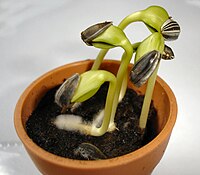
Photo from wikipedia
Environmental applications and potential risks of iron-based materials have attracted increasing attention. However, most previous studies focused on a single material. Comparative research using different iron-based materials under the same… Click to show full abstract
Environmental applications and potential risks of iron-based materials have attracted increasing attention. However, most previous studies focused on a single material. Comparative research using different iron-based materials under the same experimental conditions is still lacking. Here, six iron-based materials, including micro-sized and nanoscale Fe3O4 (i.e., mFe3O4 and nFe3O4), bulk and bare nanoscale zero-valent iron (i.e., mZVI and B-nZVI), starch-supported nZVI (S-nZVI), and activated carbon-supported nZVI (A-nZVI), were studied to compare their phytotoxicity in mung bean grown in suspensions with doses of 0, 300, 600 and 1000 mg/L. Taking the four toxicology parameters (seed germination rate, germination index, seedling elongation and biomass) together, the iron-based materials except mFe3O4 generally produced no significant phytotoxicity to mung bean even at 1000 mg/L. nFe3O4 and B-nZVI showed no higher phytotoxicity than their micro-sized counterparts (mFe3O4 and mZVI). All the materials resulted in increased Fe concentrations in seedlings particularly in roots, and mZVI and B-nZVI produced more significant effects. However, the Fe in the roots was difficultly translocated to the shoots. Compared to B-nZVI, nFe3O4 had lower bioavailability and bioaccumulation potential. XRD results confirmed that most Fe3O4 and B-nZVI remained unchanged during seedling growth, while support materials accelerated the corrosion and transformation of S-nZVI and A-nZVI. In conclusion, the tested nanoscale iron-based materials generally possess no obvious phytotoxicity within the dose range, but cause excess Fe accumulation in seedlings. Introduction of support materials may reduce such risk, allowing safer applications of these iron-based materials.
Journal Title: Chemosphere
Year Published: 2020
Link to full text (if available)
Share on Social Media: Sign Up to like & get
recommendations!